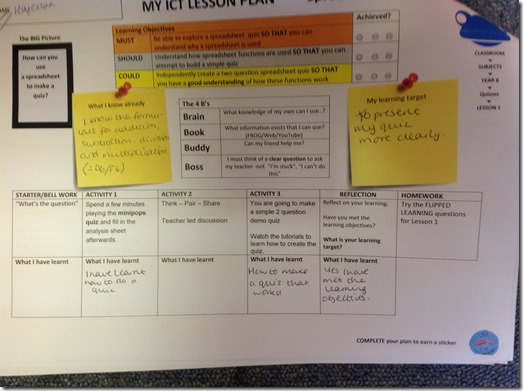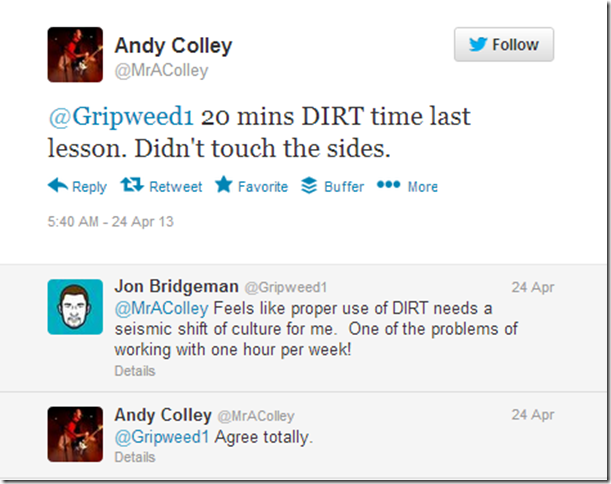I have been trying to look at ways of developing independent learning skills in my classroom this year, and as usual it was via Twitter, that I found my way to Dan Aldred’s excellent website and discovered Learning Placemats. (Bearing in this in mind, any credit for the original idea should go to Dan and any blame for its clumsy execution should be directed at me!)
What are Learning Placemats? They’re an interesting idea, flipping the idea of Teacher Toolkit’s 5 minute lesson plan on its head. Students are presented with, essentially, a lesson plan, guiding them through the structure and content of the lesson, along with the means to support themselves on their journey through the lesson.
I took Dan’s original template (check the link to his site, were he has provided the source files) and tried to produce an ICT version, that also enabled me to focus on developing the students’ independent learning skills. You can get a less blurry version of my version from here should you so desire.
The key elements of my version of the LPM were:
- Lesson Objectives (with a simple method of allowing students to self-assess progress against them)
- The 4B’s model
- Spaces for students to reflect on learning at the beginning and end of the lesson
- Information about where they could find the lesson’s resources on the VLE
- Outline of the key tasks, with spaces to reflect on their learning from each one.
To (mis) quote Jim Smith, from the introduction of his excellent “Lazy Teacher’s Handbook” the idea was to..
“Put the responsibility of learning directly and consistently onto the students. In doing so they learn to engage with their own learning, and not just in what they have learnt but in how they have learnt it”
So not at all ambitious then.. (for my next trick, I will unicycle blindfold over the Niagra Falls, whilst doing Gangnam Style) Still, in for a penny in for a pound
I decided to try LPM (as they shall henceforth be known) with all three of my Year 8 groups. All three groups are mixed ability and there is a very wide mix of students across all three.
I was about to start a spreadsheet topic with all groups and I have always found this aspect of ICT challenging to teach as students either seem to “get it” or they don’t, thus giving me very polarised groups. My thinking was that if I could enable the student to work independently for the most part, I would allow the confident students to work at a pace that suited them, while I would be able to better support the less able. I also hoped to remove need for students to depend on me for even the most basic pieces of information. I’m sure that a few of you are familiar with at least some of these questions too ..
- What am I supposed to be doing?
- How do I do it?
- I have finished. What do I do next?
- Where do I find out the information I need?
- What do I do when I get stuck?
- What did we do last week?
- What is the homework for this week?
Using LPM in class
The placemats would be out on their desks as they came into the room (I am lucky enough to have my own classroom so I was able to manage this without any problems) and it became the norm for the students to fill in the “What I know already” section as a bell-work activity.
While there would be some “whole class” activities across the project – some starters, self and peer evaluations – I increasingly left it to the students to decide how they would work. They came to see some of the lesson tasks as more of a “suggestion” then something they had to do. Nearly all of the resources they needed to learn the skills necessary to complete the tasks were uploaded onto the VLE.
I tried to establish a climate of minimal questions – I have established the 4B’s with my classes this year – and referred to rules on the sheet. When I say “minimal questions” what I mean is those “low level” questions – i.e. where are the resources, what do I do next, how do I do that – that I referred to earlier
I tried to make use of “DIRT” (Dedicted Improvement and Reflection Time) in each lesson. There was “reflection time” built in towards the end of each lesson, where I would ask students to think about what they had done in each activity, leading them to set a target for the following week. Students were given time at the beginning of the following lessons to use as they saw fit. I also rewarded students who completed every section of their LPM.
The LPM’s were used in all seven lessons in my project and here are my thoughts on how it went…
Some WINS and positive outcomes
 1) I was very pleased with project outcomes in all three groups – I would go as far as to say that all three groups achieved produced their best work of the year. There is plenty of evidence of progress for every student.
1) I was very pleased with project outcomes in all three groups – I would go as far as to say that all three groups achieved produced their best work of the year. There is plenty of evidence of progress for every student.
2) For the most part, my role seemed to change during this project – while there was some whole class teaching, I spent much more time supporting students than whole-class teaching.
3) As a result, I found that I was able to get a good understanding of where each student was at, since my time was spent with individual students. This was very useful during DIRT as I was able to support the less able students by helping them to identify the progress that they had made and suggest appropriate targets for next time. I could give my time to the students that needed it, knowing that I wasn’t impeding the progress of students at the other end of the scale who wanted to go further but didn’t know how.
4) At the basic level, students were better at managing themselves and supporting each other. There was far more evidence of students at least trying to solve their own problems, if not always succeeding. Some students were still guilty of asking the VERY basic questions that they should have been answering themselves. For the most part, the culprits responded to me tapping the LPM in front of them and the rest were made to endure the process of me asking them where THEY thought the resources were.
In terms of their progress the LPM started to make more and more sense. Students were able to use them to support learning at their own pace and questions about “what do I do next?” disappeared almost completely. The progress made by the most able was considerable.
6) There was some evidence of independent learning – I saw students use skills that I know I didn’t teach them and, while I am aware that this is a generalisation, I would say that the most able students flourished while I was able to encourage the less able to achieve more than they might have otherwise.
Some EBI’s and things to reflect on
1) Dependency is ingrained into a lot of students. For some, it is almost a Pavlovian response to being asked to do something. I am increasingly starting to believe that breaking these habits is something that can’t be done in isolation by a few staff. Even at the end of the project, there were more than one or two still clinging onto their learned behaviours.
2) The quality of the reflective work on the LPM’s varied considerably. Less able students found it hard to reflect on their learning in a meaningful way and it was hard for them to articulate what they had learnt in writing. I think that a way around this will to be to encourage students to record their learning in a wider variety of ways, something which will be easier to do as our school moves towards a BYOD environment (for example, by using something like Evernote to record voice notes) Still, I believe that it is the time allowed for this rather than the method which is key. Speaking of time…
4) Making effective use of DIRT is very hard in ICT – like many schools, we only have an hour a week in Key Stage 3 and projects tend to be 6 or 7 weeks long. When most of my teaching time is dedicated to “getting through the content” it is often hard to allocate the time I would like, to getting students to *think* about what they are doing. Andy Colley and I have both lamented the challenge of managing DIRT appropriately in ICT:
I am envious of colleagues with the time to use DIRT properly and in awe of any who do it with similarly scare resources. (I would point any ICT types towards Andy excellent blog where he talks about how he manages it)
The end of project evaluation I did with the students asked them to consider process as well as outcome but they did find this hard, even I provided a WAGOLL. There is work to be done here.
5) Arguably, the learning was inhibited by what I provided in terms of the resources I used to support it. Not all students enjoy learning from tutorials and some just aren’t able to do it. Some students just respond better to being taught, by a teacher. In addition I have to consider, that if I am truly trying to get students to develop independent learning skills, I need to explore the possibility of using more open ended projects.
6) Producing one LPM per week wasn’t too arduous but in subject where there are two or more lessons a week, one might want to think about changing the format slightly
7) I could and should have got some pupil voice feedback from the project. I am sure that the structure and design of my version of the plan could be improved and I can’t believe that all 75 of my Year 8 pupils were able to use them effectively, just like I can’t imagine 75 teachers would look at the same version of the 5 minute plan without wanting to tweak it at least slightly.
In summary…
Overall I have had a very positive experience of using LPM. They have led me to further consider if there is a difference between independent working and independent learning and, exactly what combination of those two things took place in my classroom. Gut feeling? There is a difference, and what I got was a little from column ‘A’ and a little from column ‘B’. They key thing though is that I DID see independence from my students and that gives me encouragement to persevere. I haven’t met the lofty ambition ideals described in my Jim Smith quote, but perhaps this is another tool in my armoury which lead me towards achieving this.
While the outcomes have not been perfect I think that the idea has enough potential to warrant further exploration and I’m going to use them again and I’m in process of planning a second project.
I’d like to thank Dan for being good enough to publish and share his resource in the first place and I’d love to hear from anyone who has used the LPM – either successfully or unsuccessfully – and has a story to tell about it.



